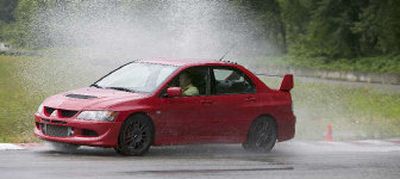Rocketship-like Evo not for the timid

It’s early; daylight’s another two hours away. I pull Mitsubishi Lancer Evolution IX out of the garage into a field of snow.
The driveway lies to the right, 200 feet uphill buried under 4 inches of snow. Under the hood, a 2-liter, intercooled, turbocharged four idles restlessly.
I push a button on the dash, adjusting the torque-split to its “snow” setting. I slip the short-throw shifter into first, take a deep breath and slam the throttle to the floor.
The tach races to the redline (it’s limited from a dead stop to 5,500 rpm to help prevent damage to precious innards). Down below, four fat Blizzak snow tires scrabble for traction. The Evo edges forward in a floaty, dreamlike frenzy, anxious to go, but fighting for grip.
I nudge the wheel to the right, toward the driveway. In “snow” mode, the center differential sends most of the power to the front tires. If the Blizzaks do their job, they’ll pull the Evo in the correct direction.
The steering wheel is alive in my hands. I shift again and keep the throttle on the floor. The back end comes around and begins to drift sideways. I ease the wheel a quarter-turn to the left. A rooster tail of snow sprays wildly in the rearview mirror.
The tail end continues its sideways slide as the car gains momentum. I apply another quarter-lock of turn and the tail begins to rotate back into line. A touch of countersteer prevents it from continuing through the axis, which could set me fishtailing crazily.
We’re two-thirds up the driveway and all four Blizzaks are pulling in the same direction. The Evo rockets forward but a hard right-hander lies dead ahead. At the top there are houses, cars, cats — and though the Evo is capable of threading that needle, I’m not. I ease off the throttle and the rev counter plummets. My heart rate drops, too, although it takes a few blocks.
Winter is one big reason the Inland Northwest will never be the center of the sports-car universe. Most sports cars are rear-drivers and pretty much useless in the snow. The best place for a sports car during the winter months is the garage.
Not the Evo. Based on the championship rally cars of the same name, it’s meant to be driven in the worst of conditions and this year adds to its skill-set. It makes more power — and more of it at lower rpm — ride and handling are improved and the center differential adjusts infinitely to a constant stream of input, both manual and electronic.
Priced from just under $30,000, the Evo runs the 0-60 sprint in 4.4 seconds and the quarter-mile in 13-and-change. In the MR trim we tested, it will hit 150 mph and with its standard-issue Yokahamas, it manages 0.98 lateral G’s on the skidpad.
There are three versions of the Evo, all using the same running gear.
The least expensive is the track-ready RS ($29,744, including destination). In the interest of weight and price savings, it omits such niceties as anti-lock brakes, power windows, stereo, remote locking, map lights and intermittent wipers.
The midlevel model, known simply as IX, is priced at $31,994, and gains back the RS deletions.
Both models get a five-speed manual transmission.
The MR ($36,894) gets all the above, plus monotube Bilstein shock absorbers, lightweight BBS forged-alloy wheels, six-speed gearbox, Xenon headlights, a body-colored Vortex generator and a more sophisticated center differential.
RS and MR models get an aluminum roof panel and decklid made of extra-thin steel to reduce weight and bring down the center of gravity, improving handling. A three-gauge package tracks turbo performance.
All models share the same powerplant, which gains 15 horsepower this year, but more importantly, generates all of its 289 foot-pounds of torque at just 3,500 rpm, so it’s not only quicker than the old model but also more pliable in everyday conditions.
The five-speed gearbox has more closely spaced ratios than before, making it easier to keep the engine in its sweet spot. All models get beefy Brembo disc brakes.
For ‘06, a handful of exterior upgrades lend a more aggressive stance, while newly enlarged front intake scoops add cooling air to the turbocharger; because it’s denser, cooler air produces a stronger explosion and more power.
The rear wing gets a hollow cross-piece this year for further weight reduction and a set of body-colored vortex-generators line the roof’s trailing edge, creating turbulence that helps keep the rear-end planted at high speeds.
The Spartan interior includes deeply bolstered Recaro seats — they’re newly finished in Alacantra pseudo-suede and trimmed in leather — that lock the driver firmly in place during the most radical maneuvers.
The driving position is exceptional and the titanium-spoked Momo steering wheel is of ideal heft and diameter.
Remarkably, this ultra-high-performance sport sedan even has a useful rear seat.
Terrific front seats, real back seats and a pair of cupholders; what else matters?
The Evo is one of those cars that don’t even try to hide their mechanicals; it’s noisy and it’s — not crude, exactly, but extremely forthright. Its purpose is performance and few compromises are made that would blunt that mission.
Mitsubishi sells fewer than 5,000 Evos a year, but it’s enough that next year there will be an all-new Evo. The mind boggles.